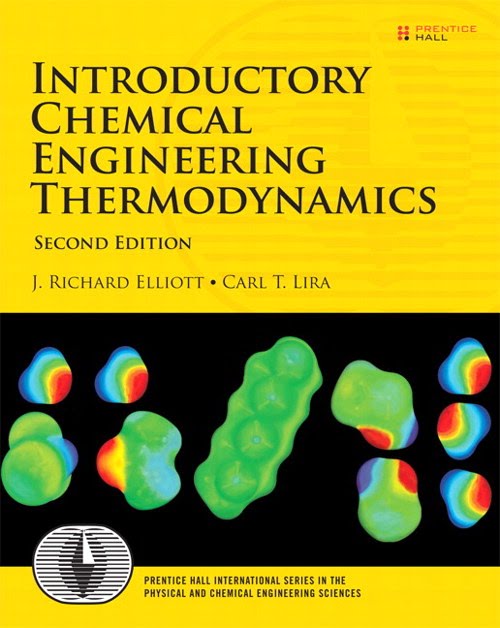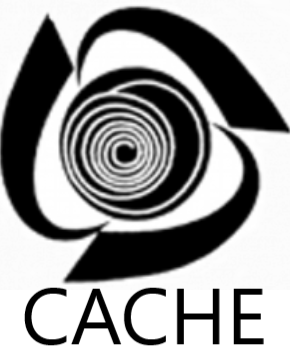
Introductory Chemical Engineering Thermodynamics (2nd Ed.)
J.R. Elliott and C.T. Lira
Also, check out our list of interactive simulations to accompany each chapter of this textbook.
1 Basic Concepts
1.1 Introduction
1.2 Molecular Nature of Energy, Temperature, and Pressure
1.4 Basic Concepts
1.5 Real Fluids and Tabulated Properties
2 The Energy Balance
2.1 Expansion/Contraction Work
2.4 Lost Work Versus Reversibility
2.6 Path Properties and State Properties
2.7 The Closed-System Energy Balance
2.8 The Open-System, Steady-State Balance
2.13 Energy Balances for Process Equipment
2.15 Closed and Steady-State Open Systems
2.16 Unsteady-State Open Systems
3 Energy Balances for Composite Systems
3.1 Heat Engines and Heat Pumps - The Carnot Cycle
3.3 Introduction to Mixture Properties
3.5 Mixture Properties for Ideal Solutions
3.6 Energy Balance for Reacting Systems
4 Entropy
4.1 The Concept of Entropy
4.2 The Microscopic View of Entropy
4.3 The Macroscopic View of Entropy
4.4 The Entropy Balance
4.6 Entropy Balances for Process Equilibrium
4.7 Turbine, Compressor, and Pump Efficiency
4.8 Visualizing Energy and Entropy Changes
4.9 Turbine Calculations
4.10 Pumps and Compressors
4.13 The Irreversibility of Biological Life
4.18 Homework Problems
5 Thermodynamics of Processes
5.1 The Carnot Steam Cycle
5.2 The Rankine Cycle
5.3 Rankine Modifications
5.4 Refrigeration
5.5 Liquefaction
6 Classical Thermodynamics - Generalizations for any Fluid
6.2 Derivative Relations
7 Engineering Equations of State for PVT Properties
7.1 Experimental Measurements
7.2 Three-Parameter Corresponding States
7.5 Cubic Equations of State
7.6 Solving the Cubic Equation of State for Z
7.14 Homework Problems
8 Departure Functions
8.1 The Departure Function Pathway
8.3 Entropy Departure Function
8.5 Summary of Density-Dependent Formulas
8.7 Implementation of Departure Formulas
9 Phase Equilibrium in a Pure Fluid
9.1 Criteria for Phase Equilibrium
9.2 The Clausius-Clapeyron Equation
9.3 Shortcut Estimation of Saturation Properties
9.4 Changes in Gibbs Energy with Pressure
9.5 Fugacity and Fugacity Coefficient
9.6 Fugacity Criteria for Phase Equilibria
9.7 Calculation of Fugacity (Gases)
9.8 Calculation of Fugacity (Liquids)
9.12 Temperature Effects on G and f
10 Introduction to Multicomponent Systems
10.1 Introduction to Phase Diagrams
10.2 Vapor-Liquid Equilibrium (VLE) Calculations
10.3 Binary VLE Using Raoult's Law
10.4 Multicomponent VLE Raoult's Law Calculations
10.7 Nonideal Systems
10.8 Concepts for Generalized Phase Equilibria
10.9 Mixture Properties for Ideal Gases
10.12 Activity Coefficient and Fugacity Coefficient Approaches
11 An Introduction to Activity Models
11.1 Modified Raoult's Law and Excess Gibbs Energy
11.2 Calculations Using Activity Coefficients
11.5 Modified Raoult's Law and Excess Gibbs Energy
11.6 Redlich-Kister and the Two-Parameter Margules Model
11.7 Activity Coefficients and Special Compositions
11.10 Relations for Partial Molar Properties
11.11 Distillation and Relative Volatility of Nonideal Solutions
11.12 Lewis-Randall Rule and Henry's Law
11.13 Osmotic Pressure
12 Van der Waals Activity Models
12.2 The van Laar Model
13 Local Composition Activity Models
13.2 Wilson's Equation
13.6 COSMO-RS Methods
14 Liquid-Liquid and Solid-Liquid Phase Equilibria
14.1 The Onset of Liquid-Liquid Instability
14.2 Stability and Excess Gibbs Energy
14.3 Binary LLE by Graphing the Gibbs Energy of Mixing
14.5 VLLE with Immiscible Components
14.6 Binary Phase Diagrams
14.7 Plotting Ternary LLE Data
15 Phase Equilibria in Mixtures by an Equation of State
15.2 Fugacity and Chemical Potential from an EOS
15.4 VLE Calculations by an Equation of State
17 Reaction Equilibria
17.1 Introduction
17.2 Reaction Equilibrium Constraint
17.3 The Equilibrium Constant
17.4 The Standard State Gibbs Energy of Reaction
17.5 Effects of Pressure, Inerts, and Feed Ratios
17.7 Temperature Dependence of Ka
17.8 Shortcut Estimation of Temperature Effects
17.12 Energy Balances for Reactions
17.14 Solid Components in Reactions
17.17 Gibbs Minimization
17.19 Simultaneous Reaction and VLE
18 Electrolyte Solutions
Other


